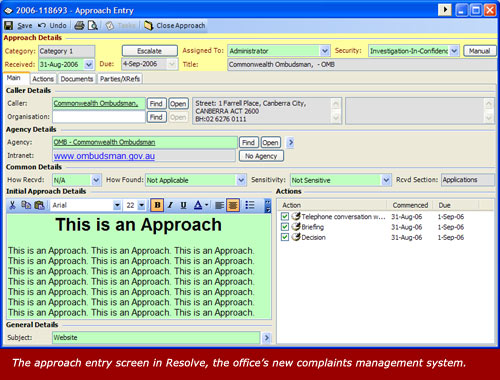Commonwealth Ombudsman Annual Report 2005-06 | Chapter 4 | Management and accountability


CHAPTER 4 | Management and accountability
Corporate governance
Senior executive and responsibilities
The Governor-General appointed Prof. John McMillan as Commonwealth Ombudsman in May 2003 and Mr Ron Brent as Deputy Ombudsman in June 2003. During 2005–06, a second Deputy Ombudsman position was created. Dr Vivienne Thom was appointed to the position in March 2006 for a five-year period. The remuneration for the Ombudsman and Deputy Ombudsmen is determined in accordance with a ruling by the Remuneration Tribunal. Note 11 in the Financial Statements details executive remuneration.
The organisational structure was further modified in June 2006, when a new Senior Assistant Ombudsman was appointed to manage the office's human resources, financial management, records management, information technology and professional standards teams.
The office's Executive team comprises the Ombudsman and two Deputy Ombudsmen. The Executive and six Senior Assistant Ombudsmen comprise the senior management team.
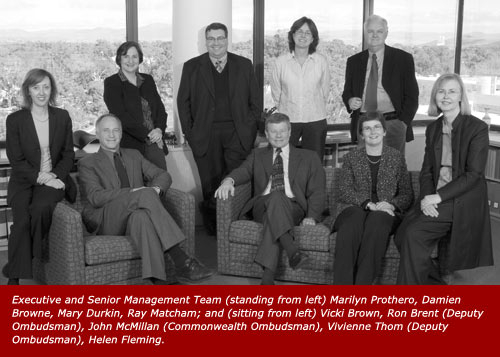
At 30 June 2006, the office's senior management team and their areas of responsibility are:
Mr Ron Brent, Deputy Ombudsman—main areas of responsibility:
- Corporate—Ms Marilyn Prothero, Senior Assistant Ombudsman and Chief Finance Officer
— corporate services comprising finance, human resources and records management
— information technology and communications infrastructure
— professional standards and special projects. - Social Support and Legal—Ms Helen Fleming, Senior Assistant Ombudsman
— specialised advice and complaint handling relating to the Department of Human Services (including Centrelink and the Child Support Agency) and relevant policy departments.
— in-house legal advice and policy service to support staff in performing their functions. - State and Territory Offices—Mr Ray Matcham, Senior Assistant Ombudsman
— management and oversight of state and territory offices (Adelaide, Brisbane, Darwin, Hobart, Melbourne, Perth and Sydney), which handle complaints and undertake some specialist work
— complaint handling relating to the ACT Ombudsman function
— Public Contact Team, which provides a national point of contact for all approaches to the office made by telephone, email or online form.
Dr Vivienne Thom, Deputy Ombudsman—main areas of responsibility:
- Immigration—Ms Mary Durkin, Senior Assistant Ombudsman
— specialised advice and complaint handling relating to the Department of Immigration and Multicultural Affairs
— reviewing the cases of detainees who have been held in immigration detention for two years or more
— investigating immigration detention cases referred by the Minister for Immigration and Multicultural Affairs, concerning Australian citizens or other people lawfully in Australia who were held in immigration detention or may have been removed from Australia. - Law Enforcement and Postal—Ms Vicki Brown, Senior Assistant Ombudsman
— complaint handling and investigating law enforcement activities relating to Australian Government law enforcement agencies
— inspecting the records of law enforcement agencies for statutory compliance, adequacy and comprehensiveness
— specialised advice and complaint handling relating to Australia Post and registered postal operators of the Postal Industry Ombudsman scheme. - Taxation, Defence and Public Affairs—Mr Damien Browne, Senior Assistant Ombudsman and Special Tax Adviser
— specialised advice and complaint handling relating to the Australian Taxation Office
— specialised advice and complaint handling relating to the Australian Defence Force, the Defence Housing Authority and the Department of Veterans' Affairs
— public affairs and outreach, including management of the office's websites and international program.
Corporate planning and review
During the year, we reviewed our strategic plan to build on achievements over the past three years and to reflect priorities for 2006–09. Strategic priorities identified for 2006–07 are to:
- consolidate the office's work practice changes introduced in 2005–06
- identify systemic issues for investigation
- continue to build the profile of the office
- increase the emphasis on timeliness, quality assurance and consistency in complaint handling
- exploit the efficiencies of our new complaints management system and work practices to target review of administrative decisions in key agencies.
The office's strategic plan informs its internal business plans. There are clear links between the objectives and the key measures of success of the strategic plan and the goals and directions set in the business plan for all teams and for staff members in their individual performance agreements. As a result, performance agreements are closely linked to business plans.
Management committees
Management committees assist the Executive with decision making in key areas.
Internal Audit Committee
As required by the Financial Management and Accountability Act 1997, the office has an Internal Audit Committee. The committee met twice during the year. The committee's role is to review, monitor and where necessary recommend improvements to internal control, financial reporting, internal audit functions, external audit processes, and the office process for monitoring compliance with legislation and government policy directives.
At 30 June 2006, the committee comprised Mr Ron Brent, Deputy Ombudsman (Chair), Ms Helen Fleming, Senior Assistant Ombudsman, Mr Ray Matcham, Senior Assistant Ombudsman, and Mr Joe D'Angelo, Chief Finance Officer, Department of the Senate.
Representatives of the Australian National Audit Office (ANAO) and the office's internal auditor, Walter Turnbull, are invited to advise the committee on specific issues, as appropriate.
Information Technology Steering Committee
A Deputy Ombudsman chairs the Information Technology (IT) Steering Committee, which met four times during the year. The committee:
- oversees the development and maintenance of IT strategy and governance
- determines priorities and directions for infrastructure, application development and maintenance, and project development
- makes recommendations to the Ombudsman about major IT infrastructure decisions and major expenditure proposals.
Occupational Health and Safety Committee
The office's Occupational Health and Safety Committee is made up of elected representatives from each state office and is chaired by the Human Resources Manager, who represents management. The committee provides its recommendations and gives advice to the Workplace Relations Committee. The committee met twice during the year. Appendix 1 gives more information on occupational health and safety.
Workplace Relations Committee
A Deputy Ombudsman chairs the Workplace Relations Committee. It consists of employee, management and union representatives, and is the main consultative body on workplace conditions within the office. The committee met twice during the year.
Work Practice Steering Committee
The Work Practice Steering Committee was established in May 2006, with the first meeting held in June. A Deputy Ombudsman chairs the committee, which includes representatives from a number of specialist teams and state offices. The committee's role is to consider and make decisions on work practice-related issues and to provide recommendations and/or advice to the Executive, where appropriate.
Corporate governance practices
Risk management
The Internal Audit Committee oversights the office's risk management activities, which have been incorporated into the Ombudsman's planning and operations and the management of contractors. The office's risk management policy and procedures specify how to:
- create, maintain and continuously improve risk management standards
- establish, maintain and continuously improve a risk register
- help to prioritise and schedule risk control improvements in each of the office's cost centres
- report to the Internal Audit Committee and Executive on risk improvement and compliance
- raise awareness among staff about risk management.
The office participated in the annual Comcover Risk Management Benchmarking Survey, and feedback was provided to the Internal Audit Committee.
Business continuity planning
Changes to the office's information technology infrastructure delayed finalisation of the business continuity plan. The draft business continuity plan identifies and assesses risks that could disrupt services and functions and presents plans to avoid or minimise the impact of hazardous incidents. The plan will be finalised in 2006–07 and tested as part of its implementation.
Fraud prevention and control
The Ombudsman's office complies with the Commonwealth Fraud Control Guidelines through:
- undertaking a fraud risk assessment
- preparing a fraud control plan
- ensuring the appropriate fraud prevention, detection, investigation and reporting procedures are in place
- collecting and reporting annual fraud control data to the Attorney-General's Department.
The office reviewed its fraud risks and controls in 2004–05. The risk of fraud remains low.
The Commonwealth Ombudsman Certified Agreement 2005–2008 includes the Australian Public Service Values, as specified in s 10 of the Public Service Act 1999, and the values adopted by the Commonwealth Ombudsman's office in its Strategic Plan 2006–2009. The importance of the values is reinforced in induction documentation and training for staff and in internal documents, including the Workplace Diversity Plan and the Workplace Harassment Policy.
The key values of the Commonwealth Ombudsman's office are: independence, impartiality, integrity, accessibility, professionalism and teamwork.
Commonwealth Disability Strategy
The office is committed to the Commonwealth Disability Strategy to ensure equality of access to the services of the Commonwealth Ombudsman for people with disabilities, and to eliminate discriminatory practices by staff. We endeavour to meet our obligations under the Disability Discrimination Act 1992 through implementation of the Commonwealth Disability Strategy and the Ombudsman's Disability Action Plan 2005–2008 and Workplace Diversity Plan 2002–2006.
The office's operations encompass the activities of regulator, service provider and employer.
Regulator
The Ombudsman does not directly enforce the disability discrimination legislation, but provides a complaint-resolution service under statute for the Australian Government. This can include recommendations on enforcement of legislative obligations that apply to Australian Government agencies. The Ombudsman seeks to promote awareness of services in all areas of the Australian community, and provides an online complaint lodgement facility on the office's website. Ombudsman staff regularly liaise with community organisations to promote awareness of the Ombudsman's services.
Provider
The Ombudsman has an established internal complaints and review process, which allows complaints about the office's decisions and service quality to be resolved quickly, fairly and informally. The office's complaint and grievance mechanisms are set out in our Service Charter. We seek to promote awareness of the office's role and service in all areas of the Australian community.
An important element in redeveloping the Ombudsman's website in 2005–06 was to ensure that the site was accessible to as large a proportion of the community as possible. To achieve this we used the priority 1 and 2 checkpoints of the World Wide Web Consortium (W3C) Web Content Accessibility Guidelines 1.0 as our benchmark. Activities included testing colour contrast for people with vision impairments, limiting the use of graphics, simplifying navigation and providing a site map, separating document formatting from content with style sheets, providing text equivalents for non-text elements, and improving metadata.
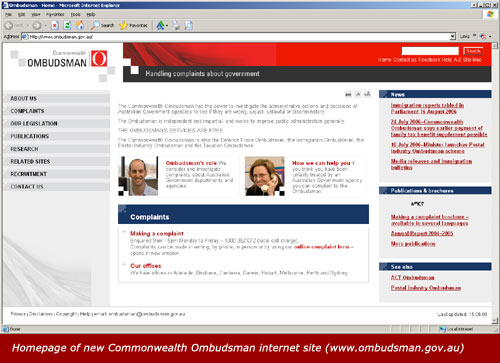
Employer
The Ombudsman's Workplace Diversity Plan aims to ensure that in working to achieve the goals of the office, the diverse background, skills, talents and views of staff are recognised, encouraged and valued, and that all staff are aware of the value of creating a culture of workplace diversity. The plan provides for the following measures to assist staff who have particular needs.
- All employment policies and procedures comply with the requirements of the Disability Discrimination Act 1992 and are communicated in a manner that is responsive to the needs of employees.
- Employment policies and procedures are made available in a format suitable to the needs of prospective employees. Appropriate material is provided in hard copy to prospective employees when they seek details of employment opportunities, as well as on the office's website in accessible formats.
- Managers and recruiters apply 'reasonable adjustment' principles.
- A flexible approach is applied to managing employees with special needs as provided in the workplace diversity plan.
- Training and development programs consider and respond to the needs of people with disabilities and include information on disability issues where they relate to the content of the program.
- Complaint and grievance mechanisms, including access to external mechanisms, are in place to address issues and concerns raised by staff and the public.
Environmental matters
Section 516A of the Environment Protection and Biodiversity Conservation Act 1999 requires the Ombudsman to report on the office's environmental performance and its contribution to ecologically sustainable development.
The Ombudsman continued to encourage staff to manage all resources, including energy, prudently and in an ecologically responsible manner. Policy guidance is provided on conservation of energy in use of lighting and computer equipment. Material sent for recycling includes toner/printer cartridges, paper and paper products, and classified waste.
Service charter
We are committed to providing the best service possible to the community. The Commonwealth Ombudsman Service Charter is available on our website. It outlines the service that can be expected from the office, ways to provide feedback and steps that can be taken if standards are not met.
Where a complainant disagrees with our conclusions and decision about a complaint, they may ask for the matter to be reconsidered, and if they are still not satisfied, for a review of how the investigation was conducted. A more senior officer not previously involved in the matter will conduct the review to determine whether the conclusion reached was reasonable, justified and adequately explained to the complainant. Only in exceptional circumstances will more than one review be undertaken. We report on reviews in Chapter 3—Performance report.
In last year's report we stated that we would review the office's service charter and the mechanisms for monitoring, responding to and recording complaints about our service. This review was held over until 2006–07 following the bedding down of the office's revised work practices and new complaints management system.
We report against timeliness in complaint handling in Chapter 3—Performance report.
External scrutiny
Privacy legislation
The Ombudsman's office is subject to the Privacy Act 1988. We continually assess our compliance with the Information Privacy Principles, which determine the way the office deals with personal information.
The Ombudsman provided information to the Privacy Commissioner for inclusion in the Personal Information Digest. The Commissioner did not issue any reports about the actions or practices of the office under s 30 of the Privacy Act in 2005–06.
During 2005–06, the Privacy Commissioner commenced an investigation into an alleged breach of privacy by the Ombudsman's office. A member of staff of the Ombudsman had made enquiries of a government agency about a matter that had been raised with our office, but at a point when the complainant did not consider he had complained. The alleged breach had occurred two years before a complaint was made to the Privacy Commissioner. The Commissioner decided that the Ombudsman's office had already taken action, through the establishment of the Public Contact Team, that would prevent any problem arising in future from uncertainty about the stage reached in the complaint process. The Ombudsman considered that the actions of his office were reasonable in the circumstances.
In last year's annual report, the Ombudsman reported on an Administrative Appeals Tribunal (AAT) decision in relation to compensation for a person whose personal information had been found by the Privacy Commissioner to have been wrongfully disclosed to the Ombudsman's office by an ACT Government agency: Rummery and Federal Privacy Commissioner and Anor [2004] AATA 1221. The Ombudsman was concerned that the AAT's decision would lead to reluctance by agencies to disclose information to the Ombudsman in the absence of a formal statutory notice.
In late 2005, Parliament passed the Migration and Ombudsman Legislation Amendment Act 2005. A provision of the Act provides that a disclosure of personal information to the Ombudsman will be taken to be authorised by law (and not a breach of privacy) if made with the authority of the agency and requested by the Ombudsman or believed to be relevant to an investigation. The Act also makes it possible for agencies to disclose, without compulsion or fear of the consequences, information that might be protected by secrecy provisions or that might otherwise compromise a claim for legal professional privilege.
Litigation and legal issues
In 2005–06, the Ombudsman's office was the respondent in five matters brought to the AAT by former complainants who had made requests under the Freedom of Information Act 1982 (FOI Act).
In one set of three matters (Bienstein and Commonwealth Ombudsman [2005] AATA 1227), the AAT affirmed exemptions claimed by the office and not previously conceded, and accepted the office's decision not to press its position on charges. In another matter (Bartucciotto and Commonwealth Ombudsman [2005] AATA 1109), the AAT confirmed exemptions claimed by the office, except for one part document conceded during the hearing. Another application to the AAT was made late in the reporting year. In Appendix 3—Freedom of Information Statement, this report notes a query raised by the Ombudsman in the context of a current review of the Ombudsman Act, as to whether the Ombudsman's office should be subject to the FOI Act.
In our 2004–05 annual report, we referred to an application before the Federal Magistrates Court for an extension of time in which to seek review of a decision made by the Ombudsman's office. On 18 August 2005, the court refused the application and awarded costs against the applicant.
Section 35 of the Ombudsman Act provides that the office is not compellable to provide, to a court or tribunal, information or documents obtained by the office in discharging its functions. We customarily rely on that statutory non-compellability when required by subpoena or discovery to produce information for the purposes of a legal proceeding to which we are not a party.
People Management
During 2005–06, the Ombudsman's office managed its employees in accordance with the conditions of our Certified Agreement and a number of Australian Workplace Agreements (AWAs) as well as within our obligations under the Public Service Act 1999.
Workplace relations
On 15 December 2005, the Australian Industrial Relations Commission certified a new agreement. The Certified Agreement remains in force until 30 September 2008.
The agreement focuses on people, remuneration and employment arrangements, working environment and lifestyle, further streamlining of personnel practices and processes, and performance management and improvement to underpin salary increases. Conditions are provided for Senior Executive Service (SES) staff under AWAs. A total of 143 employees were covered under the office's Certified Agreement. As statutory officers, the Ombudsman and two Deputy Ombudsmen are not included.
The Certified Agreement does not make provision for performance pay. Salary advancement through pay points within each classification is linked to performance, in accordance with the policy parameters for agreement making in the Australian Public Service. SES AWAs provide for annual salary advancement within the range based on performance.
The office's Workplace Relations Committee continues to provide a forum for discussion of issues surrounding implementation and operation of the agreement. It also provides a consultative, advisory and information-sharing mechanism for management and employees on matters affecting employment conditions in the office.
Staffing profile
As at 30 June 2006, the actual number of employees was 153, which included the Ombudsman and two Deputy Ombudsmen, who are statutory appointments. This total figure includes seven employees on long-term leave without pay. The number of full-time employees was 133 and the number of part-time employees was 13. The full-time equivalent number of employees for the year was 140.
During the year, 38 employees were engaged on an ongoing basis and 17 ongoing employees left the office, equating to a turnover rate of 12% (16% in the previous year). Given the nature of the office's work and the fact that we run eight offices throughout Australia, the turnover is not disproportionate.
The numbers of ongoing and non-ongoing employees, by gender and APS classification and salary range, are shown in Table 4.1. The seven employees on long-term leave without pay under the Prime Minister's Directions 1999 are not included in the table. Table 4.2 provides the office's staffing profile by location.
Table 4.1 Staffing profile, by level and gender, at 30 June 2006
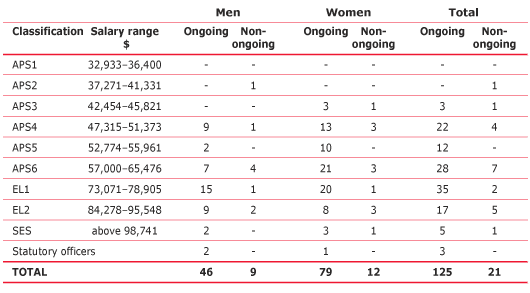
Table 4.2 Staffing profile, by location and gender, at 30 June 2006
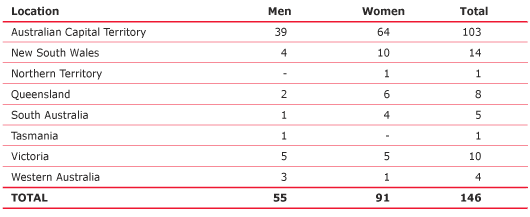
Career development and training
Career development and training focused on continuous improvement of organisational performance through analysis of needs. In 2004–05, we employed a consultant to review the office's training and development program. In 2005–06, we continued to implement the review's recommendations.
A focus for training sessions this year was to improve consistency in approach by all staff across our eight offices when dealing with complaints, and to better equip staff to move into supervisory and management roles within the office.
Training and development sessions were conducted in:
- investigations and on-the-job training
- alternative dispute resolution
- management essentials
- presentation skills
- performance management
- leading and working in small teams
- general information.
Training sessions were also conducted for all staff on the office's new work practice changes and new complaints management system. See also Chapter 5—Challenges in complaint handling.
The office also provided study assistance for staff taking courses at educational institutions and supported staff attendance at courses, seminars and conferences.
Financial Management
Financial performance
Revenue received from ordinary activities was $18.384 million in 2005–06.
The office received $17.035 million in appropriation revenue, $5.6 million more than in 2004–05. Since the 2005–06 Budget, the office has received additional funding of $19.083 million over four years to implement:
- the Palmer Implementation Plan—an expanded role in handling and investigating immigration complaints and broader immigration detention issues
- migration legislation amendments—a specific role of reviewing the cases of long-term detainees.
Total expenses for the office were $17.318 million, leading to a surplus in 2005–06 of $1.021 million, primarily due to delays in implementing the above initiatives.
Financial position
The office's total equity—that is, sum of the office's assets less its liabilities—has increased by $2.110 million, due mainly to a surplus in the 2005–06 year and equity injection of $1.089 million in relation to the Palmer Implementation Plan and migration legislation amendments.
Assets fall into four main categories:
- cash
- infrastructure, plant and equipment
- intangibles (non-physical assets such as software)
- receivables (amounts due to be paid to the office).
'Other non-financial assets' relate to prepayments.
The office's total assets increased to $6.920 million in 2005–06 from $4.081 million in 2004–05. The increases arose primarily out of an increase in undrawn appropriations, due to the delays in implementing the two major initiatives noted above. The proportion of each type of asset held during 2005–06 is set out in Figure 4.1.
Figure 4.1 Office assets by category at 30 June 2006
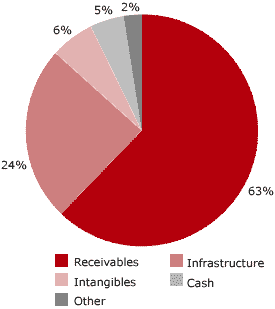
Financial assets
The Statement of Financial Position shows cash holdings of $0.333 million. This compares with the $2.157 million held in 2004–05. The decrease in cash holding is offset by the increase in undrawn appropriations. It reflects the government's policy to draw cash down from appropriation on a 'just-in-time' basis.
Non-financial assets
The office's non-financial assets increased to $2.274 million in 2005–06 from $1.668 million in 2004–05, primarily due to purchases of information technology assets.
Liabilities
Total liabilities increased by $0.731 million to $4.112 million in 2005–06, compared to $3.381 million in 2004–05. The increase was primarily due to increases in employee accruals and creditors.
Purchasing
The Ombudsman's office is committed to achieving the best value for money in its procurement practices. Purchasing practices and procedures are consistent with the Commonwealth Procurement Guidelines and are set out in the Ombudsman's Chief Executive Instructions.
Consulting services
The office engages consultants when the expertise required is not available within the organisation, or when the specialised skills required are not available without diverting resources from other higher priority tasks. In accordance with procurement guidelines, consultants are selected by advertisement, panel arrangements or selective tendering. The main categories of contracts relate to information technology, financial services, human resources services, and policy, governance and legal advice.
During 2005–06, six new consultancy contracts, with a value of $10,000 or more, were entered into, involving total actual expenditure of $380,893. In addition, two ongoing consultancy contracts were active during the 2005–06 year, involving total actual expenditure of $58,107. See Appendix 5—Consultancy services for details of new consultancy contracts. Details are also available at www.ombudsman.gov.au.
Table 4.3 shows expenditure on consultancy contracts over the three most recent financial years.
Table 4.3 Expenditure on consultancy contracts, 2003–04 to 2005–06.

Competitive tendering and contracting
In 2005–06, we continued to outsource activities relating to the provision of financial services and payroll and recruitment services as set out below:
- DuesburysNexia
Financial services to the value of $524,610 were contracted for the period 1 July 2005 to 30 June 2008, including a two-year option. This arrangement followed market testing in 2004 and evaluation of the qualitative benefits of access to accounting expertise. We have found that maintaining sufficient depth of accounting expertise in a small agency is difficult. - United Group Human Resources Services Pty Ltd
A new provider for payroll services through the Department of Prime Minister and Cabinet (PM&C) to the value of $210,100 was contracted for the period 24 February 2006 to 23 February 2009. Rel Corp Management Services Pty Ltd provided the office's payroll and recruitment services through PM&C until March 2006. Recruitment is now managed in-house.
Contractual provisions allowing access by the Auditor-General
The office's standard contract templates include an ANAO audit clause. All contracts signed in the reporting period of $100,000 or more provided for the Auditor-General to have access to the contractor's premises.
Exempt contracts
No office contracts that cost more than $10,000 including GST have been exempted by the Ombudsman from being published in AusTender on the basis that it would disclose exempt matters under the Freedom of Information Act 1982.
Information technology
The Information Technology Steering Committee continues to guide activities aimed at improving the office's use and management of information technology to support the performance of its functions.
In 2005–06, we completed several information and communications technology projects:
- implementation of a new complaints management system, involving extensive functional and specification development, analysis of office work practices and workflows, reporting requirements and integration requirements with other office products such as email
- implementation of an automatic call distribution system to manage calls to the Public Contact Team in Canberra
- implementation of a dedicated TCP/IP Wide Area Network, replacing Frame Relay Services
- upgrade of network speed/capacity to our Adelaide and Perth offices
- launch of a new internet site using a web content management system framework and an enhanced search facility. Content was improved and new features added including an improved online complaint form.
During the year, we also began several IT projects for completion in 2006–07:
- installation of a secure network access for mobility and remote access
- connection to Fedlink (a secure communication channel between the Ombudsman's office and other Australian Government agencies)
- evaluation of options for network architecture enhancements, such as replacing ageing hardware, changing the operating system and improving backup and recovery software.
